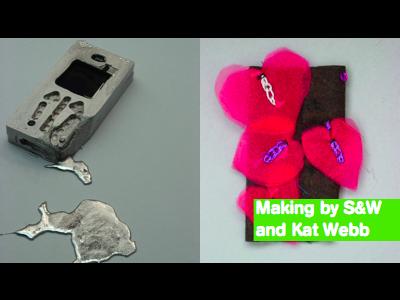
Images part of the S&W Personalisation project with Nokia, where you can read about the metal and fabric phones.
I mentioned earlier that my company’s done some work for Nokia on the topic of personalisation. There’s something in particular I want to show you, but first I’ll say what the project is about.
The premise is that the process of manufacture is trending towards shorter runs, and people want to personalise their mobile phones more and more. It turns out that if you’re making only 200 or 300 phones at a go, it’s cheaper to make them out of, say, wood, instead of tooling up a plastics factory.
The thing is, it’s very difficult for mobile phone manufacturers to think in terms of anything other than the regular phone handset. The manufacturing industry is set up to make that shape as cheap as possible, and marketing makes it hard to sell any other handset idea.
Okay, so we can help designers think about different forms of mobile phones by making them out of other materials and seeing what happens. And the materials lead to different experiences and interfaces. We found with wood, say, that buttons just don’t work. Buttons are good for plastic. The natural moves in wood include things like clacking and turning and knocking… but not pressing a little bit of it in.
You can’t tell what’s going to happen until you’ve got it in your palm. It’s really true. You have to make it.
This phone on the left is made out of a metal that melts in hot water. It goes from solid to completely runny almost instantly. That means we can melt it and make a new phone right in-front of you—and this leads to a whole vending-machine experience of choosing a phone, instead of picking a pre-made one off the wall.
The phone on the right is a fabric phone. It was just something to try. We found that layering of gauze seemed really natural. And that lends itself to a phone surface that peels off over time, or builds up. And that makes me think of patchworks, and people decorating patches for each other and swapping them. Maybe these patches include data on them, like phone numbers—but the important bit is the gift and decoration community they inhabit. There’s a lot there.
Anyway.